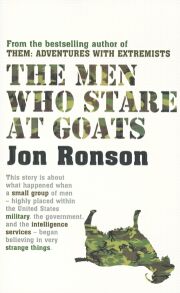After The Da Vinci Code I have learnt not to trust books that begin by saying that "this is a true story." It is pretty much an admission by the author that what is contained within the covers of the work is, well, unbelievable. It has a plausibility problem.
And I am not prone to believe conspiracy theories. Yes, the Apollo moon landings did occur. No, the CIA and the Mafia didn't shoot JFK: Lee Harvey Oswald did it.

But the more bizarre elements of Jon Ronson's The Men Who Stare At Goats are anchored in a disturbing reality that we know to be the truth. The shocking images from the Abu Ghraib prison in Iraq were too weird, too perfectly calculated to do psycho-sexual and cultural damage, to be merely a case of a couple of bored, barely literate prison guards having a lark.
What mentality, what tactic, lead to the pyramids of naked prisoners? Recent reports of Australian Mamdouh Habib being splattered with the menstrual blood of prostitutes while in captivity at Guantanamo Bay are entirely in keeping with the species of prisoner interrogation displayed at Abu Ghraib.
Ronson's story is a meandering series of interviews with ex-army personnel, false trails, intriguing rumours and investigative journalism. He struggles to make sense of it all, a feeling I, for one, share. One way of reading the story is this: that following the embarrassment of Vietnam the US military has invested heavily in alternative forms of warfare, including experiments in the paranormal. According to Ronson's sources, they even had men trying to kill goats just by staring at them. That would, I guess, give an army a certain advantage over the enemy.
In the 1970s, Vietnam vet and lieutenant colonel named Jim Channon wrote a book called The First Earth Battalion Operations Manual. Channon imagined an army of the New Age, whose soldiers "would carry with them into hostile countries "symbolic animals' such as baby lambs" (p.41). They would greet the enemy with "sparkly eyes" and give them an "automatic hug." Ambient music would be broadcast to pacify the enemy. He presented his ideas to the top brass"
Only, once the military regained its confidence, it saw that some of the ideas in the manual could be used to shatter people rather than to heal them. Loud and repetitive music (rather than noodling ambient sounds) has been used by the Psychological Operations (PsyOps) group in Panama, at the Waco siege in Texas, in Iraq and at Guantanamo Bay in Cuba. The theme tune to children's programme Barney the Dinosaur was blasted at some Iraqi detainees in a shipping container in the desert, as well as some Sesame Street favourites. Ronson records a hilarious interview with composer of some of the melodies used, who considers claiming royalties; and then he visits the PsyOps HQ to inspect their CD collection. They have Avril Lavigne, apparently.
Are the US military really experimenting with parapsychology and having battalions of men stare at goats? Some of the people Ronson interviews seem to have the obsessive intensity of the truly unhinged and lack credibility. But then " they would, wouldn't they?
There certainly are some pretty unorthodox methods being used by the US to wage war and interrogate captives. Would it really be surprising if it were true?
The point is that the War on Terror particularly and the defence of freedom generally have produced an odd kind of paranoia among some people who have the power and resources to put their whacky ideas into practice.
But there is a blindness to see that this is in itself terror of another kind. The symbolic terror of the destruction of the two towers has its counterpart in the utter shaming of the bodies and minds of these hapless captives. The ideological madness of the religious extremists on the one side is well matched by this furtive nuttiness on the side of the forces of freedom.
It makes George W. Bush's appeal (in his second inaugural address) to a common humanity made in the image of the creator ring more than a little hollow.
Michael Jensen lectures in Theology and Apologetics at Moore Theological College in Sydney.















